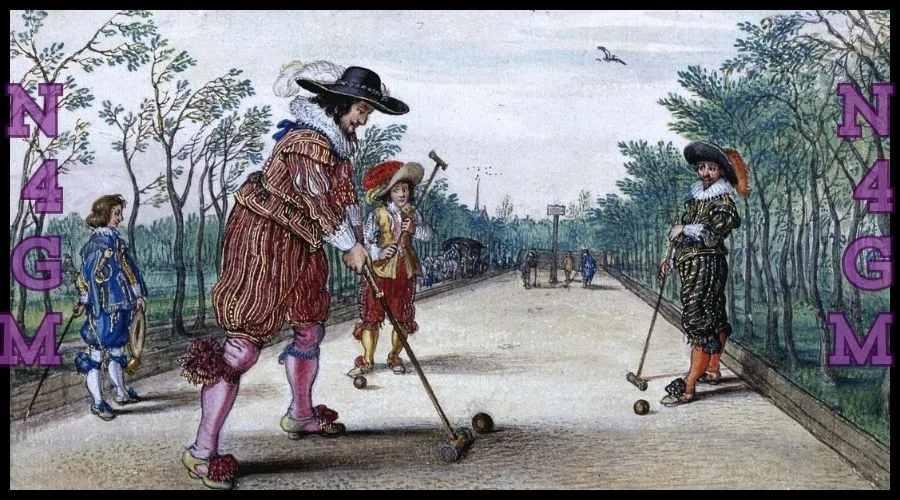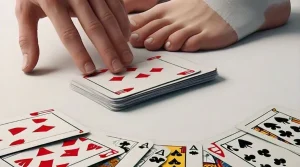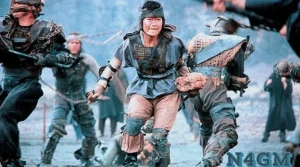Have you ever heard of the Pall Mall Game? No, I am not talking about London’s famous street. I am talking about the game! Yes, it was a very popular game in the seventeenth century. If you want to try something new or are simply interested in historical games, you’re in for a treat.
This game mixes croquet, golf, and even some medieval jousting. Doesn’t this seem interesting? Well, it is, and today I will take you on a journey through its rules, techniques, and history.
What Is Pall Mall Game?
I once had the opportunity to play an old game called Pall Mall Game, which I learned is pronounced “pell-mell.” It was an outstanding sport in the 16th and 17th century. It turns out that the word comes from the Italian phrase pallamaglio, which means “ball and mallet.”
While playing, I saw how it laid the groundwork for modern activities like croquet and golf. You use a mallet to drive a wooden ball into a hoop at the end of a long path.
This game, unlike croquet on grass, was played on a hard-packed ground surface. The idea was to get the ball through the hoop in as few strokes as possible, and I discovered that aiming for precision was essential.
Historical Background
1. Origins
Pall Mall, originally known as paille-maille, has its roots in France. The game came to England in the early 17th century. It quickly became popular, especially among the nobility.
Its true origins are debated. Some suggest ties to ancient Roman games. Others trace it to France or Italy. By the 16th century, It had firmly established itself in England.
2. Popularity Among Nobility
This sport was more than simply a casual pleasure; it became a favorite of the nobility and royalty. During King Charles I’s reign, the game became extremely popular. King Charles II, a huge admirer, even commissioned a special Pall Mall court in St. James’s Park, London.
The game was played in specific alleys, which were commonly located in parks and gardens. The nobles would meet to play. King Charles II took part. This reflected the game’s high status.
3. Widespread Influence & Decline
Historian Henry B. Wheatley said that by the 16th and 17th centuries, almost every large town had a mall for playing it. The game had a global impact. It deeply changed the landscapes of towns and cities.
The game, like many other pastimes, fell out of favor over time. Its popularity dwindled over time, and it eventually disappeared into history.
Rules & Gameplay
1. The Equipment
To play this, you’ll need specific equipment designed for the game.
The essentials include:
- Ball: A wooden ball slightly larger than a modern croquet ball.
- Mallet: A long-handled mallet with a cylindrical, wooden head. The head has a flat striking surface, perfect for hitting the ball with precision.
- Hoop (or “Pass”): Made of iron, the hoop is firmly placed in the ground at one end of the course. It’s wide enough to let the ball pass through, but not without requiring skill.
2. The Playing Field
It is typically played on a long, straight course. The length of the course can vary, but it’s generally around 1,000 yards.
The setup includes:
- Course: The surface is usually a hard-packed earth alley, not grassy fields like in croquet.
- Hoop Placement: The iron hoop is at one end of the course. Players start from the opposite end.
3. The Objective Of The Game
It’s goal is simple – get your ball through the hoop in the fewest strokes. This objective controls the game’s flow. Players compete to get the lowest stroke count.
4. Basic Rules Of Play
- Turn Order: Players take turns hitting their ball towards the hoop. The turn order is often predetermined. It may be by age or another agreed-upon method.
- Grande Passe: If a player sends the ball through the hoop on the first stroke, it’s called a “grande passe.” It’s like a hole-in-one in golf.
- Progression: If a player misses, they continue from the ball’s landing spot. They try to score in their next strokes.
- Winning: The game ends when all players have either scored or given up. The player with the fewest strokes wins the game.
5. Scoring & Penalties
Pall Mall incorporates a simple scoring system alongside strategic penalties:
- Scoring: The player with the least number of strokes to get the ball through the hoop is declared the winner.
- Penalties: A player may incur penalties for fouls such as:
- Hitting another player’s ball: The offending player must take an extra stroke.
- Out of Bounds: If the ball is struck out of bounds or missed entirely, the player may lose their turn or incur a penalty.
6. Variations In-Play
The core rules are the same. But, there may be local variations in how to play it. These twists can make the game more interesting and challenging.
Strategies For Playing
1. Aim & Precision
The foundation of success in this sport lies in your ability to aim and strike the ball with precision.
This requires:
- Judging Distance and Angle: When aiming for the hoop, consider the distance, angle, and force needed. Striking too hard may send the ball off course, while striking too softly may leave it short of the goal.
- Practice: Regular practice is key to honing your aim. The more you practice, the better you’ll get. You’ll learn to gauge the perfect strike to guide your ball through the hoop.
2. Mallet Control
Effective mallet control is another critical skill in this game.
This involves:
- Handling the Mallet: The mallet in the game is long and heavy. It needs practice to use it well. It’s not just about striking with force; it’s about striking with the right amount of force at the correct angle.
- Precision Striking: Get a feel for the mallet. It will help you hit the ball more accurately. Your shots will then be deliberate and controlled.
3. Defensive Play
It isn’t just about advancing your ball; it’s also about strategic defense.
Consider the following:
- Blocking Opponents: If an opponent is near the hoop, you can block their path by positioning your ball. This will force them to take extra strokes. This defensive tactic can give you an edge in the game.
- Anticipating Moves: Observe your opponents closely and anticipate their moves. Knowing their strategy can help you counter their tactics.
4. Reading The Course
The terrain of the game alley can significantly influence the outcome of your shots.
Here’s how to navigate it:
- Assessing the Terrain: The course may feature slopes, bumps, or uneven surfaces. Before taking your shot, study the course carefully. Knowing these nuances can help you plan your shots. It can help you avoid obstacles and use good conditions.
- Utilizing Terrain: Use the terrain to your advantage. A slope might guide your ball to the hoop. Avoiding a bump could keep your ball on course.
5. The Art Of The Grande Passe
The “grande passe” is the pinnacle of skill in Pall-Mall. It is a shot that sends the ball through the hoop.
Achieving this feat requires:
- Perfect Combination: The grande passe demands a flawless blend of aim, force, and precision. It’s a rare achievement, but when executed, it’s a highlight of any game.
- Practice and Patience: This move is hard to master. But, with regular practice and patience, you can improve your chances of success. Know your mallet and the course. It will help you perform this impressive maneuver.
6. Managing Your Strokes
Being mindful of your strokes can significantly impact your success.
Here’s how to manage them effectively:
- Deliberate Play: Sometimes, taking an extra moment to line up your shot can prevent costly mistakes. Rushing may lead to unnecessary strokes, so focus on making each strike count.
- Counting Strokes: Keep track of your strokes and aim to minimize them. Efficiency in play is key to winning in Pall-Mall.
7. Staying Calm Under Pressure
It can be an intense and competitive game, but maintaining composure is crucial:
- Cool Head: Stay calm and composed, even when the game becomes tense. Keeping your emotions in check will help you make more strategic and calculated decisions.
- Focus on the Game: Concentrate on your game rather than getting distracted by the competition. This focus will enable you to play your best, regardless of the circumstances.
8. Enjoying The Social Aspect
Lastly, remember that the game is as much about socializing as it is about competition:
- Engage with Fellow Players: Enjoy the camaraderie and social interactions of playing it. It’s a game that fosters relationships and creates memorable experiences.
- Balancing Competition and Fun: Winning is important. But, don’t lose sight of the joy in playing. Balancing competition with fun ensures a rewarding experience for everyone involved.
The Cultural Impact
1. Influence On Social & Cultural Life
This was more than a game. It was a cultural phenomenon that left a lasting mark on society, especially in England.
- Upper-Class Leisure: The upper classes, including the aristocracy and royalty, mostly enjoyed the game. It was a social activity. It brought together and fostered interactions among, the elite.
- Social Significance: Playing this sport was often seen as a symbol of status and refinement. The game was a pastime and a social event. It strengthened bonds and reinforced norms.
2. Evolution Of The Term “Pall-Mall”
Its legacy goes beyond the game. It shaped modern language and city development.
- From Game to Modern Mall: The sport became “mall.” It now means shopping areas and promenades. This evolution reflects the game’s impact on the naming and design of public spaces, particularly in urban settings.
- Architectural Influence: The idea of a “mall” as a place for leisure and socialization can be traced back to the spaces where it was played. These areas were often long, straight avenues. They later influenced the design of shopping malls and pedestrian promenades.
3. In Popular Culture
Its cultural significance is not just historical. It is also relevant to modern pop culture.
- Bridgerton and the Resurgence: The Netflix series Bridgerton prominently features it as a key social event among the characters. This portrayal has revived interest in this and the game.
- Revival of Interest: Bridgerton’s popularity has sparked a renewed interest in it. People are curious about the game’s history and are trying to play it. This revival shows the game’s timeless appeal. It captivates new audiences.
4. Lasting Legacy
The enduring legacy of the sport is a testament to its cultural impact.
- Continued Relevance: The game may not be widely played today. But, its influence is felt in modern life, from language to media.
- Historical Connection: Pall-Mall links us to the past. It shows the leisure activities of England’s upper classes. It remains a symbol of elegance and social prestige, with its legacy preserved in the cultural consciousness.
Conclusion
This is more than a game. It reflects social practices and cultural evolution. Its rules are simple, yet the strategies can be complex, making it an engaging pastime.
From experience, playing Pall Mall is not just about competition. It’s also about enjoying others’ company and the game’s rich history.







